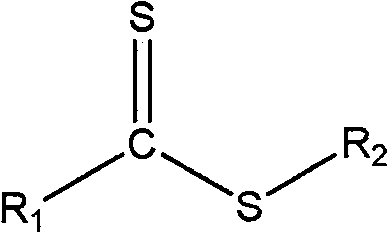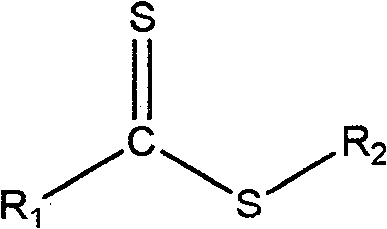Method for increasing melt strength of polypropylene
A melt strength and polypropylene technology, applied in the field of improving the melt strength of polypropylene, to achieve the effect of reducing loss, reducing dosage, and promoting grafting reaction
- Summary
- Abstract
- Description
- Claims
- Application Information
AI Technical Summary
Problems solved by technology
Method used
Image
Examples
Embodiment 1
[0023] Embodiment 1 (comparative example)
[0024] Add 100 parts by weight of polypropylene (homopolypropylene, powder, melt index 2.28g / 10min) into an internal mixer at 180°C and knead for 10 minutes to obtain a polypropylene with a melt strength of 2.5cN.
Embodiment 2
[0025] Embodiment 2 (comparative example)
[0026] Add 100 parts by weight of the polypropylene used in Example 1 into an internal mixer at 180° C., add 1 part by weight of TMPTMA after melting and plasticizing, and the mixing conditions are the same as in Example 1. The melt strength of the resulting polypropylene was 4 cN.
Embodiment 3
[0027] Embodiment 3 (comparative example)
[0028] Add 100 parts by weight of the polypropylene used in Example 1 into an internal mixer at 180°C, add 1 part by weight of TMPTMA after melting and plasticizing, and add 0.2 parts by weight of BPDH after mixing. The mixing conditions are the same as in Example 1, and the torque No change, discharge. The melt strength of the resulting polypropylene was 5.3 cN.
PUM
| Property | Measurement | Unit |
|---|---|---|
| melt strength | aaaaa | aaaaa |
| melt strength | aaaaa | aaaaa |
| melt strength | aaaaa | aaaaa |
Abstract
Description
Claims
Application Information
 Login to View More
Login to View More - R&D
- Intellectual Property
- Life Sciences
- Materials
- Tech Scout
- Unparalleled Data Quality
- Higher Quality Content
- 60% Fewer Hallucinations
Browse by: Latest US Patents, China's latest patents, Technical Efficacy Thesaurus, Application Domain, Technology Topic, Popular Technical Reports.
© 2025 PatSnap. All rights reserved.Legal|Privacy policy|Modern Slavery Act Transparency Statement|Sitemap|About US| Contact US: help@patsnap.com



